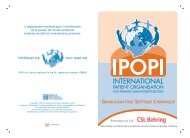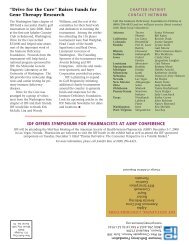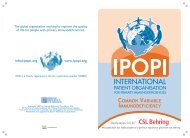IDF Patient & Family Handbook for Primary Immunodeficiency ... - IDFA
IDF Patient & Family Handbook for Primary Immunodeficiency ... - IDFA
IDF Patient & Family Handbook for Primary Immunodeficiency ... - IDFA
Create successful ePaper yourself
Turn your PDF publications into a flip-book with our unique Google optimized e-Paper software.
Specific Medical Therapy 95<br />
General Care During Specific Illness continued<br />
days later. Some patients with the more severe<br />
and persistent headaches have been found to<br />
have an increase in the number of white blood<br />
cells in the cerebral-spinal fluid, which surrounds<br />
the brain. This is known as aseptic meningitis.<br />
The cause of this apparent inflammation is not<br />
known, but it is not an infection and patients<br />
have not had permanent injury. It is bothersome,<br />
and usually requires treatment. In some patients<br />
merely changing brands of IVIG will eliminate the<br />
problem. In some cases, it is necessary to treat<br />
with a steroid, be<strong>for</strong>e, during, or after the infusion.<br />
You should notify your doctor if you experience<br />
headaches that do not respond to standard<br />
medications such as acetaminophen.<br />
The dose of immunoglobulin varies from patient<br />
to patient. In part, the dose is determined by<br />
the patient’s condition and weight. It is also<br />
determined by measuring the level of IgG in the<br />
patient’s blood at some interval after infusion,<br />
and by determining how well a given dose of<br />
immunoglobulin treats or prevents symptoms in<br />
an individual patient. Studies have shown that<br />
patients with chronic sinusitis and chronic lung<br />
diseases such as bronchitis do better when given<br />
higher doses of immunoglobulin. Some patients,<br />
who lose IgG molecules from their digestive tracts<br />
or kidneys, may require more frequent doses.<br />
It is important to remember that although our<br />
current immunoglobulin products are very good,<br />
they do not duplicate exactly what nature normally<br />
provides. The manufactured immunoglobulin is<br />
almost pure IgG, so essentially no IgA or IgM is<br />
transferred to the patient. The specific protective<br />
functions of these immunoglobulins are there<strong>for</strong>e<br />
not replaced. The IgA on the mucosal surfaces of<br />
the respiratory tract is not being replaced, which<br />
may be part of the reason that antibody deficient<br />
patients remain somewhat more susceptible<br />
to respiratory infections, even though they are<br />
receiving enough immunoglobulin to maintain<br />
normal or near-normal blood levels of IgG.<br />
Hematopoietic Stem Cell Transplantation<br />
Transplantation of stem cells from a normal donor<br />
to a recipient with a primary immunodeficiency is<br />
a highly specialized procedure that can be used<br />
to treat some primary immunodeficiency diseases.<br />
A “stem cell” is a type of cell that can produce<br />
descendants that branch into different types of<br />
cells, such as Blymphocytes and Tlymphocytes. It<br />
can also make more stem cells and continuously<br />
regenerate the pool of stem cells. Traditionally,<br />
stem cells <strong>for</strong> the immune system were obtained<br />
from bone marrow. This process was called<br />
“bone marrow transplantation.” Now, purification<br />
techniques allow separation of stem cells from<br />
peripheral blood, and blood obtained from the<br />
placenta at birth (“cord blood”). Cord blood, in<br />
particular, has been shown to provide an excellent<br />
alternative source of stem cells <strong>for</strong> the immune<br />
and blood systems. The stem cells that give rise<br />
to the lymphocytes and other cells of the immune<br />
system also make blood cells. They are called<br />
“Hematopoietic” stem cells (HSC). The process<br />
of taking stem cells from one person and putting<br />
them into another is there<strong>for</strong>e called “HSCT”<br />
or hematopoietic stem cell transplantation. The<br />
primary immunodeficiency diseases <strong>for</strong> which<br />
HSCT is most commonly per<strong>for</strong>med include<br />
those diseases that are characterized by deficient<br />
T-lymphocytes or combined deficiencies of<br />
T-lymphocytes and B-lymphocytes. HSCT<br />
is most often used to treat severe combined<br />
immune deficiency (SCID). HSCT has also been<br />
used in some patients to treat other primary<br />
immunodeficiency diseases such as the<br />
Wiskott-Aldrich syndrome, hyper-IgM syndromes,<br />
and chronic granulomatous disease.<br />
As mentioned in the chapter titled The Immune<br />
System and <strong>Primary</strong> <strong>Immunodeficiency</strong> Diseases,<br />
bone marrow is the organ in which immature cells<br />
of the immune system, the stem cells, divide and<br />
begin the developmental journey on the road to<br />
becoming mature T-lymphocytes, B-lymphocytes,<br />
and macrophages and neutrophils. In the normal<br />
fetus, there are so many stem cells that they<br />
spill out of the bone marrow which makes fetal<br />
blood and umbilical cord blood rich sources of<br />
stem cells. The transplantation of HSCs from a<br />
“normal” individual to an individual with a primary<br />
immunodeficiency has the potential to replace the<br />
deficient immune system of the patient with<br />
a normal immune system.
















